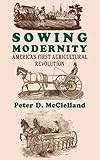Sowing Modernity : America's First Agricultural Revolution / Peter D. McClelland.
Material type: TextPublisher: Ithaca, NY : Cornell University Press, [2018]Copyright date: ©1997Description: 1 online resource (368 p.) : 270 halftones, 3 graphs, 8 tablesContent type:
TextPublisher: Ithaca, NY : Cornell University Press, [2018]Copyright date: ©1997Description: 1 online resource (368 p.) : 270 halftones, 3 graphs, 8 tablesContent type: - 9781501728655
- 630/.973 21
- S441 .M115 1997
- online - DeGruyter
| Item type | Current library | Call number | URL | Status | Notes | Barcode | |
|---|---|---|---|---|---|---|---|
 eBook
eBook
|
Biblioteca "Angelicum" Pont. Univ. S.Tommaso d'Aquino Nuvola online | online - DeGruyter (Browse shelf(Opens below)) | Online access | Not for loan (Accesso limitato) | Accesso per gli utenti autorizzati / Access for authorized users | (dgr)9781501728655 |
Browsing Biblioteca "Angelicum" Pont. Univ. S.Tommaso d'Aquino shelves, Shelving location: Nuvola online Close shelf browser (Hides shelf browser)

|

|

|

|

|

|

|
||
| online - DeGruyter A Primer on Legal Reasoning / | online - DeGruyter Drawing Distinctions : The Varieties of Graphic Expression / | online - DeGruyter The Engine of Visualization : Thinking through Photography / | online - DeGruyter Sowing Modernity : America's First Agricultural Revolution / | online - DeGruyter Judging Rights : Lockean Politics and the Limits of Consent / | online - DeGruyter Walter Benjamin and the Antinomies of Tradition / | online - DeGruyter Holy Day, Holiday : The American Sunday / |
Frontmatter -- Contents -- Preface -- 1. The Problem -- 2. The Approach -- 3. Plowing -- 4. Sowing -- 5. Harrowing -- 6. Cultivating -- 7. Reaping -- 8. Threshing -- 9. Winnowing and Straw Cutting -- 10. Novus Ordo Seclorum? -- Appendix A: Remedies for Soil Exhaustion -- Appendix B: Breeding and Raising Livestock -- Notes -- Bibliography -- Index
restricted access online access with authorization star
http://purl.org/coar/access_right/c_16ec
Contrary to those who regard the economic transformation of the West as a gradual process spanning centuries, Peter D. McClelland claims the initial transformation of American agriculture was an unmistakable revolution. He asks when a single crucial question was first directed persistently, pervasively, and systematically to farming practices: Is there a better way? McClelland surveys practices from crop rotation to livestock breeding, with a particular focus on the change in implements used to produce small grains. With wit and verve and an abundance of detail, he demonstrates that the first great surge in inventive activity in agronomy in the United States took place following the War of 1812, much of it in a fifteen-year period ending in 1830. Once questioning the status quo became the norm for producers on and off the farm, according to McClelland, the march to modernization was virtually assured. With the aid of more than 270 illustrations, many of them taken from contemporary sources, McClelland describes this stunning transformation in a manner rarely found in the agricultural literature. How primitive farming implements worked, what their defects were, and how they were initially redesigned are explained in a manner intelligible to the novice and yet offering analysis and information of special interest to the expert.
Mode of access: Internet via World Wide Web.
In English.
Description based on online resource; title from PDF title page (publisher's Web site, viewed 26. Apr 2024)


